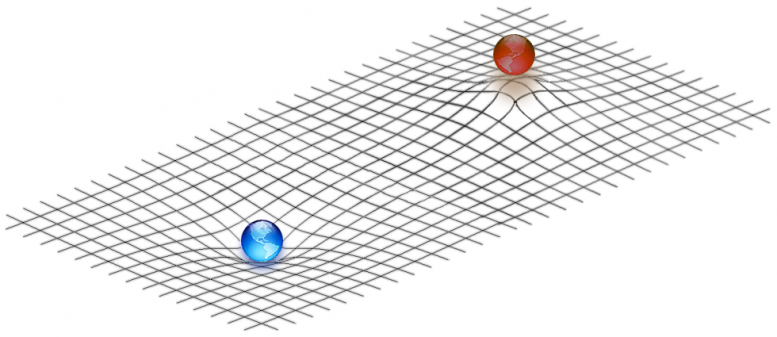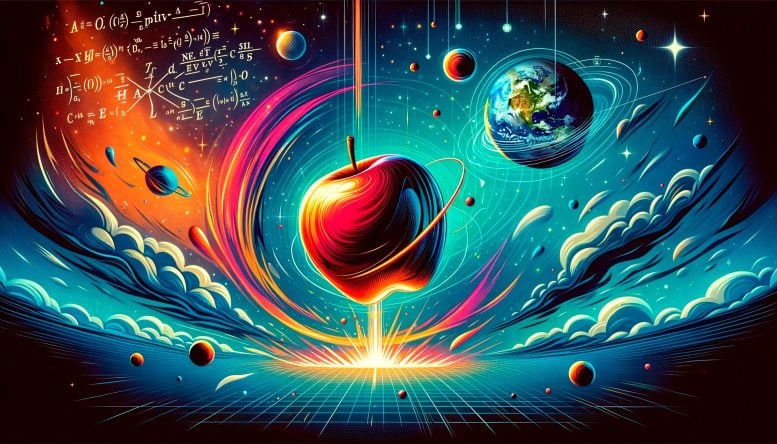Einstein’s theory of general relativity explains gravity as the result of the curvature of space-time caused by mass, in contrast to magnetism’s dual powers of attraction and repulsion. This theory introduced the concept of gravity wells, which is central to understanding gravity. Image source: SciTechDaily.com
Why does gravity pull us down instead of up?
Gravity is what causes objects with mass or energy to attract each other. This is why apples fall to the ground and planets orbit stars.
Magnets will attract certain types of metals, but they can also push away other magnets. So why do you only feel gravity?
Albert Einstein found the answer in 1915 when he published his general theory of relativity. The reason gravity pulls you toward the ground is that all objects with mass, such as our Earth, actually bend the fabric of the universe, called space-time. This curvature is the gravity you feel.
What is space and time?
Before entering the complex world of gravity, you need to understand space and time.
Spacetime is exactly what its name implies: the three dimensions of space—length, width, and height—combined with a fourth dimension—time. Einstein used some pretty brilliant mathematics to become the first person to realize that the laws of physics operate in a universe where space and time merge together.
This means that space and time are connected – if you move very fast through space, time will slow down for you compared to someone who moves slowly. This is why astronauts who move very fast in space age a little slower than people on Earth.

The Earth bends space-time so that you fall toward the Earth instead of away from it. Image credit: Tokamak/Wikimedia Commons, CC BY-SA
Matter creates gravity wells, not gravity mountains
Remember, gravity is when objects in the universe attract each other because space-time is curved. When Einstein came up with his theory of general relativity, he showed that all matter in the universe can bend space-time—in physics terms, matter is mass and energy.
Since your brain normally thinks of the world in three dimensions, it’s difficult to think of the four dimensions of space and time as a single idea. So, to make it easier to visualize, picture the surface of a trampoline. If there’s nothing on it, then it’s flat. But if you stand on a trampoline, it stretches around your feet and creates a valley centered on you. If there is a ball on the trampoline, it will roll towards your feet.

The effect of gravity is similar to how objects roll towards your feet when you stand on a trampoline.
This is a two-dimensional example of how space-time works. Your mass stretches the trampoline, creating what’s called a gravity well into which the ball rolls. This is very similar to how the gravity of a heavy object like the Earth pulls objects like you and me toward it.
What’s even weirder is that since space and time are connected, time will also be stretched by heavy objects!
In the movie “Star Effect,” the characters travel to a planet very close to Earth. black holewhile they’re there, they age more slowly than others.
The heavier you are, the steeper the sides of the trampoline well will be. This is why the truly massive objects in the universe—such as the sun or black holes—have stronger gravitational pulls than Earth.
So why does gravity pull you down instead of pushing you away?
Imagine someone goes under the trampoline and pushes up. The ball will roll away! This would be a gravity mountain, not a gravity well. As far as scientists know, matter (or matter) always creates gravity wells, not gravity mountains. Scientists can imagine things made of exotic matter or energy that would cause gravity to push you into space, but so far, no one has found anything that could cause gravity to push you away from Earth.
Author: Mario Borunda, associate professor of physics at Oklahoma State University.
Adapted from an article originally published in The Conversation.![]()
#Einsteins #Insight #Gravity #Pull
Image Source : scitechdaily.com
